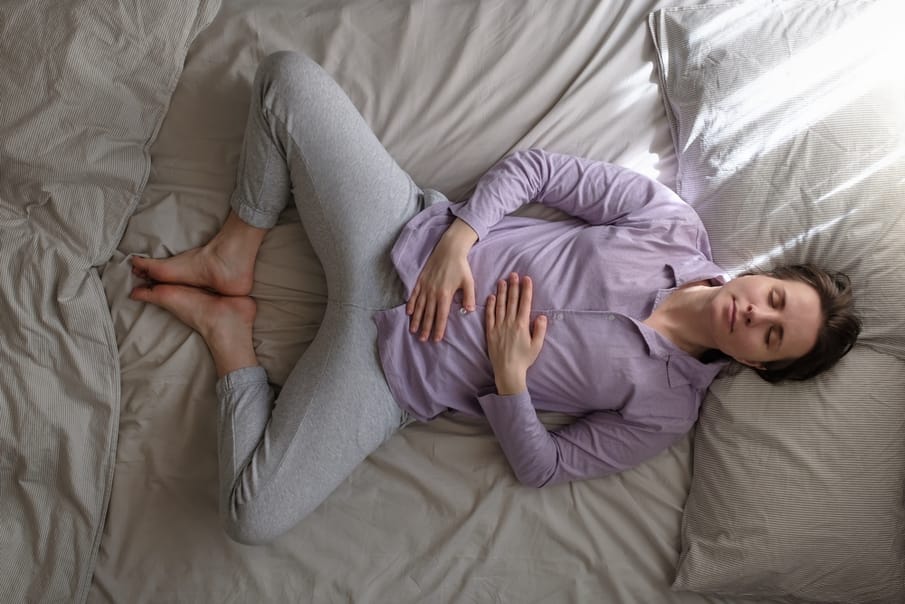Could this relaxation technique that combines the power of meditation with the comfort and cosiness of bed be the key to sleeping better at night?
Sleep: it’s a problem on a lot of people’s minds. According to Mental Health UK, one in five people in the UK don’t get enough sleep, with women and Black, Asian, and other minority ethnic adults being more likely to experience poor sleep. 66% of adults who experience poor sleep say it impacts their mental health which, in turn, can affect their ability to get quality sleep – trapping them in a vicious cycle.
Sleep is a vital pillar in our wellbeing, and yet so many of us struggle with this particular aspect – which begs the question, how do we get better sleep?
From lifestyle changes to counselling and environmental changes, there are many things you can try to improve your chances of getting some quality shut-eye. But a new thing to add to your toolkit is the simple exercise of ‘beditation’.
Beditation blends the relaxing qualities of meditation with the cosy comfort of being in your bed. Rather than meditating on a yoga mat or in a classroom, beditation encourages you to embrace total relaxation and the power of meditation at the best time, and in the best place, to set you up for a good night’s sleep.
A systematic review published in the Annals of the New York Academy of Sciences, which looked at 18 trials with 1,654 participants, found that there was moderate strength of evidence that mindfulness meditation interventions significantly improved sleep quality. These results are echoed in another study published in the journal Sleep which looked at whether mindfulness meditation could be an effective treatment for more severe chronic insomnia, and concluded that it was, and was an effective tool to offer alongside more traditional treatments for insomnia.
Now, take those benefits and combine them with a sense of cosiness and you’ve really got something golden. It almost goes without saying that feeling comfortable and secure has a positive impact on your wellbeing. At the end of a long day, retreating to our own personal sanctuaries can help us decompress and begin the process of switching off. Changing up our environment is a physical, tangible sign that we’re transitioning from day to night, and can help us to get in the right mindset for sleep.
So, ready to give it a go?
Setting up your environment
-
Set the mood. Make sure your bedroom is dark or only lit by a low light if you prefer.
-
Switch tech to silent. You will probably be using some form of technology to play your meditation track, so ensure that it is set to silent or that your notifications are turned off so that you are not disturbed during the meditation.
-
Get comfortable. The goal is to be as comfortable and supported as possible, so that you are able to totally let yourself go. So, to do that, consider a couple of factors. Firstly, what’s the temperature like in the room? Do you need an extra blanket or to make yourself a hot water bottle? Or do you maybe need a lighter duvet or sheet, or to switch on a fan? Next, scan your body and work out if there are any areas that you need to offer extra support. For example, do you need to put an extra cushion under your knees or below your elbows? How is your head supported, and is that comfortable? Throw out any ideas about how you should be positioned for meditation, and find what works best for you.
Finding the perfect meditation
-
Where to look. There are a huge variety of both free and paid-for meditations out there, and you can begin your search on sites such as YouTube and Spotify, or head to apps like Calm and Headspace.
-
Finding a meditation that works for you. We all respond differently to different styles of meditation. Finding one that clicks with you will depend on the approach, the topic, and even the tone of the voice in the recording. Try listening to a couple of different meditations ahead of time to figure out what works best for you.
-
Aim for relaxation. There are meditations for every occasion, from motivation to self-love. But the aim of beditation is to get you ready for a good night’s sleep, so try to pick one that is either designed specifically for sleep or for deep relaxation.
When it comes to finding what works best for you, you’ll often need to try out a few different things. So, if better sleep is on your list of goals, try adding beditation to your toolkit. You could be pleasantly surprised.


Comments